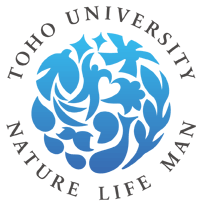|
東邦大学理学部物理学科 素粒子物理学教室 |
|---|
投稿論文、関連論文集OPERA"Final Results of the OPERA Experiment on ντ Appearance in the CNGS Neutrino Beam", Phys. Rev. Lett. 120 (2018) 211801 (7 pages). 【Editors' Suggestion】 "Study of charged hadron multiplicities in charged-current neutrino-lead interactions in the OPERA detector", Eur. Phys. J. C 78 (2018) 62 (8 pages). "Determination of the muon charge sign with the dipolar spectrometers of the OPERA experiment", JINST 11 P07022 (2016). "Discovery of &tau Neutrino Appearance in the CNGS Neutrino Beam with the OPERA Experiment", Phys. Rev. Lett. 115 (2015) 121802 (7 pages). "Limits on muon-neutrino to tau-neutrino oscillations induced by a sterile neutrino state obtained by OPERA at the CNGS beam", JHEP 06 (2015) 069(13 pages). "Observation of tau neutrino appearance in the CNGS beam with the OPERA experiment",Prog. Theor. Exp. Phys. 2014 (2014) 101C01(10 pages). 【2016年日本物理学会論文賞】 "Evidence for νμ → ντ appearance in the CNGS neutrino beam with the OPERA experiment", Phys. Rev. D 89 (2014) 051102(R)(6 pages). "New results on νμ → ντ appearance with the OPERA experiment in the CNGS beam", J. High Energy Phys. 11 (2013) 036(31 pages). "Search for νμ → νe oscillations with the OPERA experiment in the CNGS beam", J. High Energy Phys. 07 (2013) 085(15 pages). "Search for νμ → ντ oscillationwith the OPERA experiment in the CNGS beam", New J. Phys. 14 (2012) 033017(17 pages). "Observation of a first ντ candidate event in the OPERA experimentin the CNGS beam", Phys. Lett. B 691 (2010) 138-145. "Measurement of the atmospheric muon charge ratio with the OPERA detector", Eur. Phys. J. C (2010) 67: 25-37. "The detection of neutrino interactions in the emulsion/lead targetof the OPERA experiment", JINST 4:P06020, 2009. "The OPERA experiment in the CERN to Gran Sasso neutrino beam", JINST 4:P04018, 2009. "Study of the effects induced by lead on the emulsion films of the OPERA experiment",JINST 3:P07002, 2008. "Emulsion sheet doublets as interface trackers for the OPERA experiment",JINST 3:P07005, 2008. "First events from the CNGS neutrino beam detected in the OPERA experiment",New Journal of Physics 8 (2006) 303 1-14. Study of hadron interaction background in OPERA"Study of hadron interactions in a lead-emulsion target", Prog. Theor. Exp. Phys. 2014 (2014) 093C01: 1-13. "Automatic track recognition for large-angle minimum ionizing particles in nuclear emulsions",Journal of Instrumentation 9 (2014) P12017 0-11. "Automatic scanning of nuclear emulsions with wide-angle acceptance for nuclear fragment detection",Journal of Instrumentation 8 (2013) P01023 0-12. NINJA/T60"First measurement using a nuclear emulsion detector of the νμ charged-current cross section on iron around the 1 GeV energy region", Prog. Theor. Exp. Phys. 2021, 033C01 (2021). "First measurement of numu and numubar charged-current inclusive interactions on water using a nuclear emulsion detector", Phys. Rev. D 102, 072006 (2020). "First neutrino event detection with nuclear emulsion at J-PARC neutrino beamline", Prog. Theor. Exp. Phys. 2017, 063C02 (2017). "First demonstration of an emulsion multi-stage shifter for accelerator neutrino experiments in J-PARC T60", Prog. Theor. Exp. Phys. 2017, 063H02 (2017). SHiP"The active muon shield in the SHiP experiment", JINST 12 P05011 (2017). CHORUS final results and the emulsion tracker"Measurement of charm production in neutrino charged-current interactions",New Journal of Physics 13, (2011) 093002 (15pp). "Final results from a search for νμ → ντoscillations with the CHORUS experiment", Nucl. Phys. B. 793, 326-343 (2008). "The large area emulsion tracker of the CHORUS experiment",Nucl. Instr. and Meth. A 488 (2002) 144-154. Belle"Search for B+ → D*+π0 Decay", Phys. Rev. Lett. 101:041601 1-5, 2008. "Search for B0 → Λc+ Λc- decay at Belle", PRD 77, 051101(R) (2008). "Improved measurement of mixing-induced CP violation in the neutral B meson system", Phys. Rev. D 66 (2002) 071102(R). AshraDouble hypernucleus"The first evidence of a deeply bound state of Xi- - 14 N system",Prog. Theor. Exp. Phys. 2015 (2015) 033D02 (11 pages). 【2017年日本物理学会論文賞】 "Double - Λ hypernuclei observed in a hybrid emulsion experiment", Phys. Rev. C 88 (2013) 014003(10 Pages). "Nuclear capture at rest of Ξ- hyperons", Nucl. Phys. A 828 (2009) 191-232. "Observation of a ΛΛ6 He Double Hypernucleus", Phys. Rev. Lett. 87 (2001) 212502. "Quasifree p(K-, K+)Ξ- reaction in nuclear emulsion", Nucl. Phys. A 644 (1998) 365-385. Charmed Particles"Upper Limits for Charm Hadron Decays to Two Muons plus Hadrons", Phys. Lett. B 345 (1995) 85 - 92. "Hadroproduction of D DPairs in the Interaction of 350 GeV/c π- Mesons with Nuclei", Prog. Theor. Phys. 87 (1992) 1315-1322. "Measurement of the Relative Branching Fraction Γ(D0 → K μ ν)/Γ(D0 → μ X)", Phys. Rev. Lett. 66 (1991) 1819-1822. Emulsion spectrometer and related techniques"A new method to correct deformations in emulsionusing a precise photomask", Nuclear Instruments and Methods in Physics ResearchA 711 (2013) 1-7. "A thin emulsion spectrometer using a compact permanent magnet.", Nuclear Instruments and Methods in Physics Research A 592 (2008) 56-62. Produced by Toho University.
|
